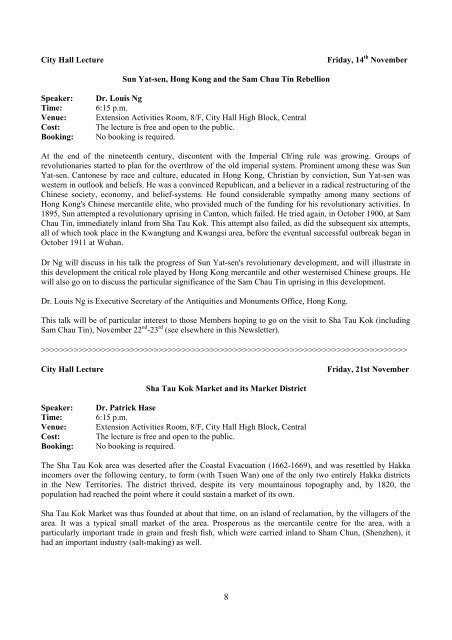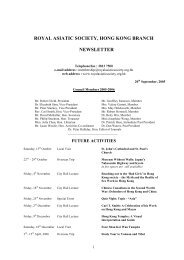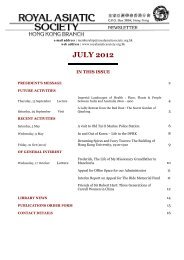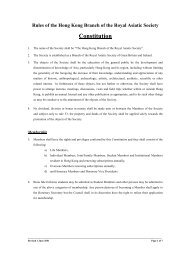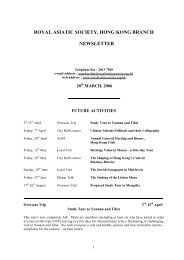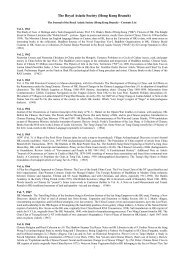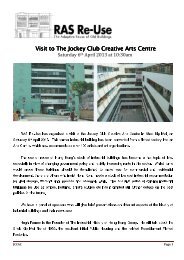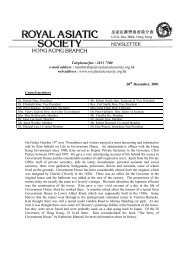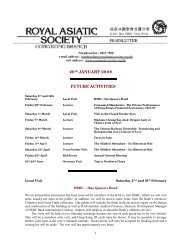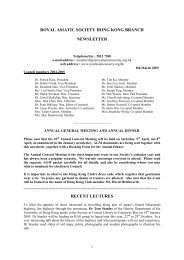of interest to members - Royal Asiatic Society Hong Kong Branch
of interest to members - Royal Asiatic Society Hong Kong Branch
of interest to members - Royal Asiatic Society Hong Kong Branch
You also want an ePaper? Increase the reach of your titles
YUMPU automatically turns print PDFs into web optimized ePapers that Google loves.
City Hall Lecture Friday, 14 th November<br />
Sun Yat-sen, <strong>Hong</strong> <strong>Kong</strong> and the Sam Chau Tin Rebellion<br />
Speaker: Dr. Louis Ng<br />
Time: 6:15 p.m.<br />
Venue: Extension Activities Room, 8/F, City Hall High Block, Central<br />
Cost: The lecture is free and open <strong>to</strong> the public.<br />
Booking: No booking is required.<br />
At the end <strong>of</strong> the nineteenth century, discontent with the Imperial Ch'ing rule was growing. Groups <strong>of</strong><br />
revolutionaries started <strong>to</strong> plan for the overthrow <strong>of</strong> the old imperial system. Prominent among these was Sun<br />
Yat-sen. Can<strong>to</strong>nese by race and culture, educated in <strong>Hong</strong> <strong>Kong</strong>, Christian by conviction, Sun Yat-sen was<br />
western in outlook and beliefs. He was a convinced Republican, and a believer in a radical restructuring <strong>of</strong> the<br />
Chinese society, economy, and belief-systems. He found considerable sympathy among many sections <strong>of</strong><br />
<strong>Hong</strong> <strong>Kong</strong>'s Chinese mercantile elite, who provided much <strong>of</strong> the funding for his revolutionary activities. In<br />
1895, Sun attempted a revolutionary uprising in Can<strong>to</strong>n, which failed. He tried again, in Oc<strong>to</strong>ber 1900, at Sam<br />
Chau Tin, immediately inland from Sha Tau Kok. This attempt also failed, as did the subsequent six attempts,<br />
all <strong>of</strong> which <strong>to</strong>ok place in the Kwangtung and Kwangsi area, before the eventual successful outbreak began in<br />
Oc<strong>to</strong>ber 1911 at Wuhan.<br />
Dr Ng will discuss in his talk the progress <strong>of</strong> Sun Yat-sen's revolutionary development, and will illustrate in<br />
this development the critical role played by <strong>Hong</strong> <strong>Kong</strong> mercantile and other westernised Chinese groups. He<br />
will also go on <strong>to</strong> discuss the particular significance <strong>of</strong> the Sam Chau Tin uprising in this development.<br />
Dr. Louis Ng is Executive Secretary <strong>of</strong> the Antiquities and Monuments Office, <strong>Hong</strong> <strong>Kong</strong>.<br />
This talk will be <strong>of</strong> particular <strong>interest</strong> <strong>to</strong> those Members hoping <strong>to</strong> go on the visit <strong>to</strong> Sha Tau Kok (including<br />
Sam Chau Tin), November 22 nd -23 rd (see elsewhere in this Newsletter).<br />
>>>>>>>>>>>>>>>>>>>>>>>>>>>>>>>>>>>>>>>>>>>>>>>>>>>>>>>>>>>>>>>>>>>>>>>>>>>>>><br />
City Hall Lecture Friday, 21st November<br />
Sha Tau Kok Market and its Market District<br />
Speaker: Dr. Patrick Hase<br />
Time: 6:15 p.m.<br />
Venue: Extension Activities Room, 8/F, City Hall High Block, Central<br />
Cost: The lecture is free and open <strong>to</strong> the public.<br />
Booking: No booking is required.<br />
The Sha Tau Kok area was deserted after the Coastal Evacuation (1662-1669), and was resettled by Hakka<br />
incomers over the following century, <strong>to</strong> form (with Tsuen Wan) one <strong>of</strong> the only two entirely Hakka districts<br />
in the New Terri<strong>to</strong>ries. The district thrived, despite its very mountainous <strong>to</strong>pography and, by 1820, the<br />
population had reached the point where it could sustain a market <strong>of</strong> its own.<br />
Sha Tau Kok Market was thus founded at about that time, on an island <strong>of</strong> reclamation, by the villagers <strong>of</strong> the<br />
area. It was a typical small market <strong>of</strong> the area. Prosperous as the mercantile centre for the area, with a<br />
particularly important trade in grain and fresh fish, which were carried inland <strong>to</strong> Sham Chun, (Shenzhen), it<br />
had an important industry (salt-making) as well.<br />
8


